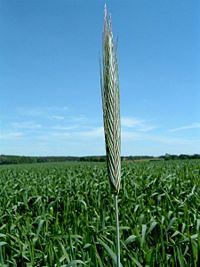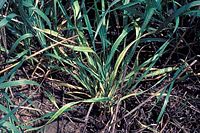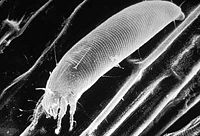Wheat streak mosaic virus
For the course duration, the article is closed to outside editing. Of course you can always leave comments on the discussion page. The anticipated date of course completion is May 21, 2009. One month after that date at the latest, this notice shall be removed. Besides, many other Citizendium articles welcome your collaboration! |
| Wheat Streak Mosaic Virus | ||||||||
|---|---|---|---|---|---|---|---|---|
 | ||||||||
| Virus classification | ||||||||
|
Description and Significance
Wheat Streak Mosaic Virus (WSMV) cannot live and reproduce by itself. WSMV is transferred through wheat curl mite to the crop. This mite is an arthropod. It is so extremely small in size that it cannot be seen with the naked eyes. Overall, the mite serves as a vector for the WSMV to get to the wheat. The wheat is the favorite food source and place to live for both the mite and the WSMV. As the mites reproduce, the WSMV is also passed down to the mites’ progeny. The peak reproduction of mites occurs when the temperature is warmer in spring around 75-80˚F. Here, the WSMV is also replicated and reproduced progressively as the mites population multiply in number.
Massive numbers of mites are carried to the wheat field through the wind blow. WSMV from the mites then would infect the wheat. WSMV virus is the cause of the wheat disease. The symptoms resulted from the WSMV infection are very distinct from other virus. The wheat's leaves turn yellowish and have narrow bands. There are blotches on the leaves with different patterns. The normal growth of the wheat is hindered. If the infection is more severe, the leaves can turn completely brown and die off. The total yield of the wheat drops down significantly. If the infection is severe, the loss can be up to 100%.
Distribution
In the US, the WSMV infection is heavily found in the midwest: North Dakota, Kentucky, Michigan, Minnesota and Ohio.The fall and spring wheat field suffer the detrimental effects significantly. Now the virus infection is moderate in control as the scientists understand more about the causes, effects and mechanisms of virus transmission. The most prevalent infection occurred in 1987-1988. Recently, WSMV also found in Virginia in 2000
In the world, according to the data collected by US Department of Agriculture, the other countries that are also known to suffer from WSMV disease are Canada, Jordan, Rumania, Australia, Yugoslavia, Russia.
Genome structure
The WSMV is positive, linear, single-strand RNA (ssRNA). According to the International Committee on Taxonomy of virus, the complete genome of WSMV has 9384 nucleotides. The G+C content is 44%. The percent of coding is 97%. The sequence only codes for one long polypeptide. This long polypeptide has both structural and non-structural proteins. In the image provided from pubmed reference page on the left, the long polynucleotide sequence code for 10 proteins: P1 protein, HC-Pro protein, P3 protein, 6K1 protein, CI protein, 6K2 protein, NIα-VP9 protein, NIα-Pro protein, NIb protein and coat protein.
According to three research articles from Virology, Plant Journal and Phytopathology, some of the functions of these genes have been revealed. P1 and HC-Pro have proteinase activity. In addition, NIa is the proteinase as well but it also codes for VPg sequences. CI is the inclusion body protein and shared by a type of RNA helicase. NIb is is RNS-dependent RNA polymerase. The coat protein has carboxy terminal. Functions of the P3, 6K1 and 6K2 are still unknown.So far P1 and Hc-Pro gene hav been the two genes of WSMV that have the greatest number of studies. Some researchers even knock out the the HC-Pro gene and observe the effects on the virus.
Furthermore, there are many different strains of the same WSMV. Some are milder than others. The strains are sorted out based on the damages and severity of symptoms on different wheat's types. So far, three strains have been isolated from US, Eurasia and Mexico. Studies have shown that these strains are mosaic and differ in there nucleotide sequence by 10 to 20%. Five isolated strains of WSMV have their nucleotide sequences studied completely by researchers. These five strains are AF057533, AF285169, AF285170, AF454454 and AF454455. Their detailed sequences are deposited in the bank for further study and use in the future.
Virus structure
The virus is in group IV, family Potyviridae, genus Tritimovirus. The virus is simple in structure. The virus has helical capsid. It is naked and doesn't have envelope. The capsid has spiral arrangement in a long tube, about 700 nm in length, and 15nm wide. The single strand RNA is enclosed within the helical capsid. Researchers usually use uranyl acetate and phosphotungstate to stain the virus for electron microscopy.
The WSMV had similar appearances with other three viruses are agrpyron mosaic, ryegrass mosaic and hordeum mosaic virus. It was thought that WSMV had a close interconnection with those viruses. However, recent studies have revealed that there is no relationship found between those viruses.
Characteristics of wheat cells that are infected with WSMV
The wheat cell bears many inclusions in the cytoplasm. The nucleus is distorted in shape. The inclusions do not have any rigid shape. They are varied in appearance. The inclusions are involved with viral proteins. There is an increased reproduction rapidly in number of membranes and ribosome’s. As the infections go on and progress, the cells is twisted out of shape and the organelles are disintergrated.
Other possible hosts for WSMV
The virus not only attacks all sorts of wheat but also the other cereal plants. The other cereal plants are oats, barley, rye, maize, millets and sorghum. Wild grass is also affected. If there cereal plants and wild grass are grown in very close distance to the infected wheat crop, they can catch the mites by wind and develop WSMV soon. However, young wheat is still the number one ranged from the favorite host of mite and WSMV. Mites and WSMV only attack the other cereal plants when the wheat crops are severe damaged, grown old, degraded in nutritional values
How to indentify the wheat infected with WSMV
It’s hard to differentiate the normal, healthy wheat from the early infected wheat that hasn’t had any apparent, visible symptoms yet. Plant pathologists usually use electron microscope or perform Enzyme Linked Immunosorbent Assay test (ELISA). These tests were conducted in the labs by entomologists and plant pathologists. In ELISA test, the sap of infected plants is collected in antivirus serum. The result of the test is then compared with the known sap with WSMV. The more similarities between the reference and unknown sap, the more likely the plant is infected with WSMV.
Some of other viruses also have early infection's symptoms similar to WSMV infection. Another test that plant pathologists also can use to confirm the presence of WSMV is the Immunosorbent Electron Microscopy (ISEM). This method involves in incubation of antiserum coated grids with virus suspensions. Different viruses have different trapping results.
Ecology
The virus's favorite natural habitat is wheat. It uses the wheat curl mite as a vector. The relationship between the virus and the wheat is parasitism. The virus takes advantage of the wheat and grows at the cost of the wheat's development.
Summary
Importing file
The image above basically summarizes the infection cycle of virus in spring and winter wheat. Winter wheat crop starts to have early infection in the fall. The virus travels along with mites. The mites originate from infected spring wheat crop, volunteer wheat and grass. These mites are carried by the wind to the seeding winter wheat. Young, fresh, seedling wheat are best-loved food of both the mites and the viruses. As time goes on and the disease progresses, the winter wheat crop is stunted and yellowed, and dies prematurely.
The infection in spring wheat depends on the mites that survive from the winter wheat. Infection starts even earlier if the spring crop is grown near the infected winter wheat crop. The volunteer wheat plays an important role between winter and spring wheat crop. Volunteer wheat usually grows in between the young and infected fields. It bears the reservoir of mites and acts as a mean for the mites to jump to the young wheat field nearby. Infected volunteer wheat from winter gives rise to infection in wheat in spring, and infected volunteer wheat in spring crop in turn is responsible for infection of wheat in next fall.
Furthermore, the grass and corn crop nearby are also a reservoir of infection. The mites also can live in these hosts when all the wheat crops have deprived all nutritive values and died out. The mites stay in here and leave for the wheat later if the nearby wheat field are seeding and growing. Beside damage to the wheat, the virus is also indirectly gives a detrimental effect to the human. The wheat infection outbreak due to WSMV has given a great loss of money to the wheat food manufacture industry. Fall infection can result in up to 50% loss. Loss of spring infection is around 20%. An example is 1995 oubreak in Montana. The loss was $35 million. Even now, in Kansas, WSMV is responsible for the loss of 20 million dollars annually.
Pathology
The WSMV only infects cereal plants and hinders the growth of wheat. It does not infect angiosperms or humans
Recommendation for control measures
There are no type of wheat exists that shows resistant to the WSMV. Therefore, control measures have been suggested to avoid serious crop loss. In addition, it is important to understand that control virus infection also relates to control of mite population. Since the virus cannot travel by itself. It needs a vector to get to the host. Without the vector as its motor vehicle, the virus will not be present in the new crop and spread out infection. Some of the control methods are:
1)Delay seeding & plant winter and spring wheat at different days: Delay seeding has been shown to be helpful. Mites reproduce maximally when the temperature is warm. As the mites reproduce, the virus also passes along the progeny. Without the host, mites only can survive up to two days. Delay seeding when the weather is a little bit colder somewhat will control mite transmission because the cold weather is unfavorable to the mites' being. This is most helpful for winter wheat crop when the temperature drops down in winter time. Delay seeding also helps with spring wheat. In the mid-west states as Minnesota, North Dakota, the wet and rainy days in the summer makes the mites to stay where they are. Mites only can be carried by the wind when the it is a dry day. Wet weather helps prevent mite's mobilization. In turn, it also helps us to prevent virus spreading out. In some states, the planting days are set for each local county. These official planting days set up in local office make each of the next step easier to implement in a time-line manner.
2)Destroy volunteer wheat and grass hosts: In North West Minnesota, the researchers have advised the farmers to control the volunteer wheat first before they plant new wheat crop. This method targets in breaking the mite & virus transmission to the new, young, growing crop. If there are no volunteer wheat around, the mites have less chance to jump around.
3)Don't plant susceptible young wheat crop in proximity to the infectious crops to prevent mite's movement: Infection occurs with higher frequency and greater extent when the young crops grow in very close distance to the infectious crops. The young, nutritious wheat crops are always the target of the mites. Since one cannot control the direction of wind blow, this method somewhat decreases risk factors of mite mobilization. If space is not limited, one should plant the two crops as far as possible is always the best.
4)Use chemical agents: Chemical reagents are used to kill volunteer wheat and grass, since these are the temporary hosts where the mites can stay on. It is important to know that chemical control only helps to prevent mite's reproduction and mobilization. Once the wheat crops have been infected, the chemical method is not an effective method to implement anymore. The common chemical reagent use is Glycophosate [N(phosphonomethyl) glycine]. This herbicide is expensive. It works well to kill the plants but it doesn't work right away. The volunteer wheats and grass do not die overnight but several weeks later. The effectiveness of this herbicide also depends on the weather. It works best when the weather is rainy. During these rainy days, mite population have been shown to reduce significantly. When the days are dry all months long, this herbicide doesn't work much. Even now, there are cases that the volunteer wheat has died down but mite's population maintains and continues to spread out. This is probably due to the mites' adaptation, so their resistance increases over time.
There are always pros and cons for using the chemical control. One side is that the chemical should be effective to kill the mites, but at the same time the hazardous level also should be monitored in proper moderation. If the herbicide is too harzadous, it may harm the crops and indirectly harm us, the wheat's consumers. The chemical use and dosage also should be a particular concern when use this method.
Overall, every method has its own strengths and weaknesses. Control virus infection or mite mobilization should use the combination of all the methods. The plans should be conducted in a timeline manner and includes all the elimination of mite's reservoirs.
Application to Biotechnology
"Wheat Streak Mosaic Virus: From Harmful to Helpful", by Jan Suszkiw
WSMV has been known as the cause for the loss of wheat industry. The plant pathologist, and his team, takes advantage of the virus as the fact that this virus attacks on the wheat leaves. Stengers’ team use WSMV as a vector to transfer the new genes into the wheat genome and manipulate the wheat for better resistance and crop yield. Using the WSMV in this way is faster and the efficiency of gene transfer in genetic engineer.
Current Research
"Diallel Analysis of Wheat streak mosaic virus Resistance in Winter Wheat" by Frederic Hakizimanaa, Amir M. H. Ibrahim, Marie A. C. Langhama, Scott D. Haleyb and Jackie C. Ruddc
“Complete Deletion of Wheat Streak Mosaic Virus HC-Pro: a Null Mutant Is Viable for Systemic Infection” by Drake C. Stenger, Roy French, and Frederick E. Gildow
In this research, the authors work on a WSMV that doesn’t have HC-Pro. The researchers use the technique in vitro transcription and translation to confirm with the deletion of HC-Pro. The deleted HC-Pro fails to compete with the wild type WSMV. Its reproduction is reduced. This can suggest the possibility to modify WSMV.
"Evolution of Wheat Streak Mosaic Virus: Dynamics of Population Growth Within Plants May Explain Limited Variation" by FRENCH, R.C., STENGER, D.C.
This research focuses on the genetic variantion of WSMV and the evolution lineage of viral RNA and WSMV. French and Stenger also have indentified approximately 50 variarions of WSMV. They suggest that the effective virus are much smaller than the actual virus population there are. They also suggest the factors that influence the evolution of WSMV and the patterns of genetic drift during their development
References
[1]http://www.ncbi.nlm.nih.gov/sites/entrez?Db=gene&Cmd=Search&TermToSearch=NC_001886[accn]
[2]http://www.ncbi.nlm.nih.gov/sutils/gmap.cgi?result=map&acc=NC_001886&organism=2451
[3]http://www.ncbi.nlm.nih.gov/ICTVdb/ICTVdB/00.057.0.06.001.htm
[4]http://www.dpvweb.net/dpv/showdpv.php?dpvno=393
[5]http://en.wikipedia.org/wiki/Wheat_streak_mosaic_virus
[7]http://www.ars.usda.gov/research/publications/publications.htm?seq_no_115=145703
[8]http://findarticles.com/p/articles/mi_m3741/is_12_48/ai_68864545/
[10]http://www.dpvweb.net/dpv/showdpv.php?dpvno=48
[11]http://www.actahort.org/books/127/127_12.htm
[12]http://nwroc.umn.edu/Cropping_issues/2008/Issue10/07_22_08_no7.htm
[13]http://nu-distance.unl.edu/Homer/disease/agron/wheat/WhStrMo.html
[14]http://plantmanagementnetwork.org/pub/php/research/2004/wheat/
[15]http://www.oznet.ksu.edu/path-ext/factSheets/Wheat/Wheat%20Streak%20Mosaic%20Virus.asp



